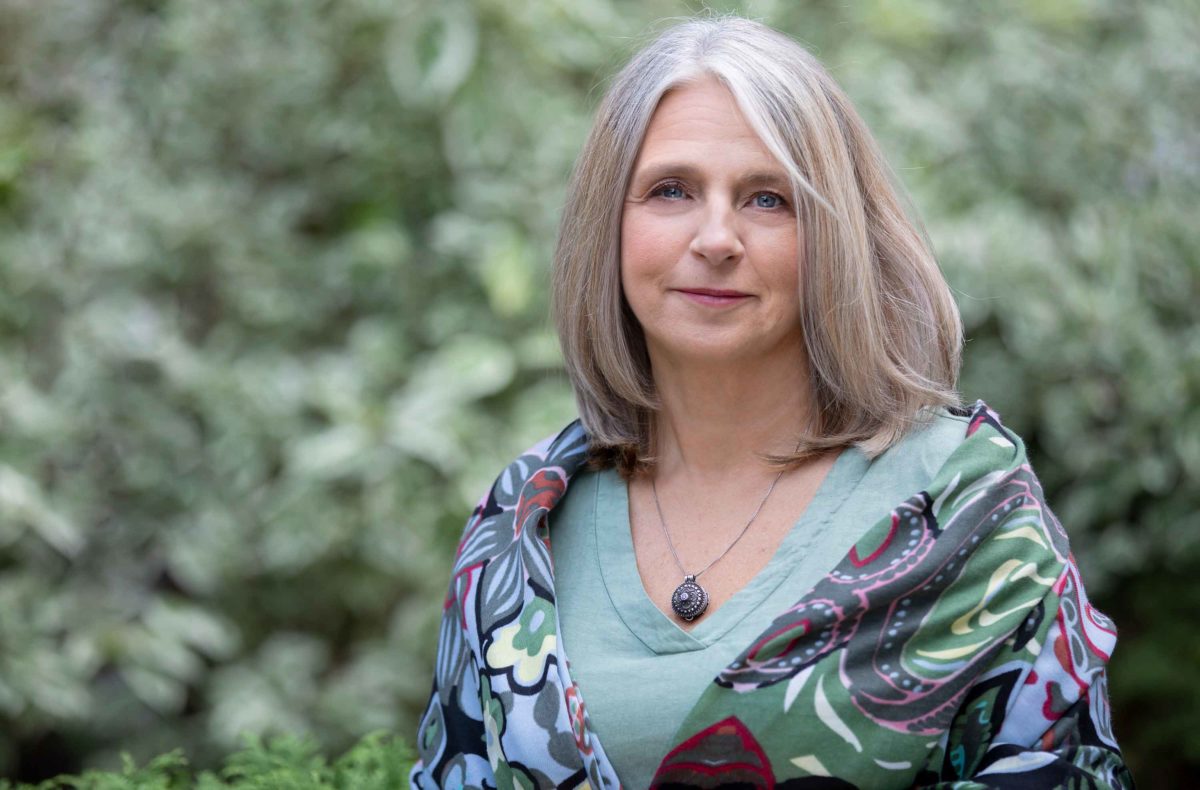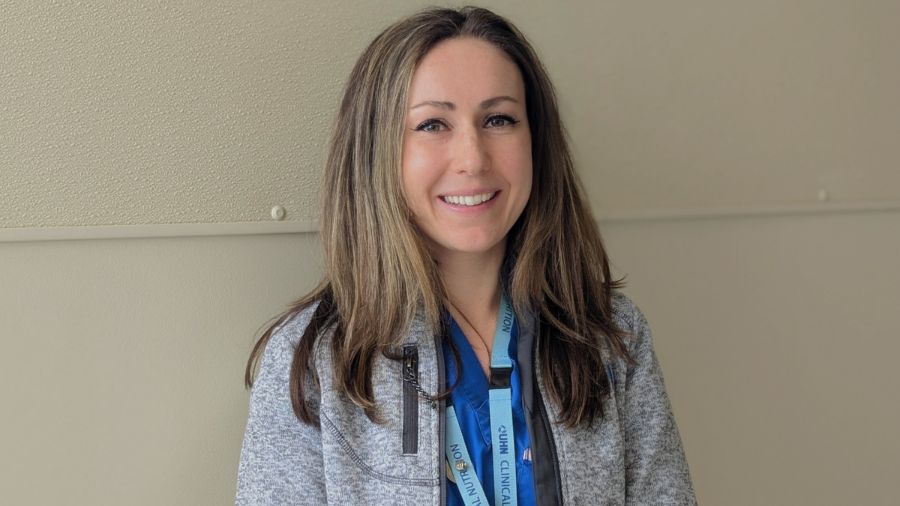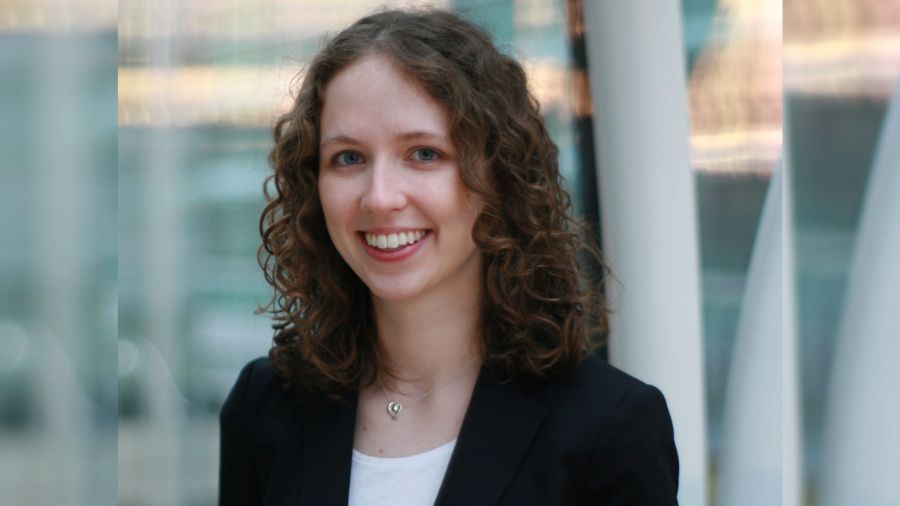This International Artist Day, learn how the Al & Malka Green Artists’ Health Centre provides crucial support to a community of creators – especially when it’s needed most. Pictured above is Claire Doyle. (Photo: Jen Squires)
When Claire Doyle contemplates the past two years of her life, she’s quick to dish out thanks. Among those atop the singer-songwriter’s list is University Health Network’s Al & Malka Green Artists’ Health Centre, specifically Dr. Anita Shack, Head of Chiropractic Services at the Centre.
In February 2020, Doyle – whose stage name is Claire Davis, and whose collaborators include Daniel Caesar, Charlotte Day Wilson and Jessie Reyez – lost her father. To compound her grief, the COVID-19 pandemic hit the next month. Confronting her new reality was profoundly difficult, but Dr. Shack’s compassion was a welcomed support.
“[Dr. Shack] has been an incredible asset to me through this very transitional period in my life. I was going through a lot of really big shifts, and she was there to help me through them. I can’t say enough good things about her or the Centre,” Doyle says.
Placing artists centre stage
With philanthropy, the Artists’ Health Centre was established in 2002. The only clinic of its kind in Canada, it offers specialized care to the artistic community, including chiropractic medicine, naturopathic medicine, psychotherapy, physiotherapy, registered massage therapy and shiatsu therapy. A nurse practitioner is also one of the Centre’s specialists.
The integrated team collaborates to provide the best treatment possible, Dr. Shack says. A holistic approach is adopted when caring for artists, some of whom receive subsidies thanks to donor support. If not for this, many artists would be unable to access care at the Centre.
Doyle, who is grateful for the subsidy, initially sought treatment for neck and back pain. Dr. Shack delivered chiropractic treatment, followed by acupuncture and craniosacral therapy, a relaxing, light-touch intervention that works to release tension, allows the body to unwind and regulates the autonomic nervous system.
Delivering a range of therapies is routine for Dr. Shack, who has practised for more than 35 years and who has been involved with the Centre since its inception. A former dancer, she is passionate about the arts and the artistic community, and embraces the Centre’s slogan: healthy artists, vibrant cities.
Given her background and experience, Dr. Shack is attuned to the unique circumstances and stressors faced by artists. This knowledge informs her model of care.
“Who artists are and what they do are very enmeshed. Obstacles to creating or performing have serious ramifications, not only for their physical and mental health, but for how they function in life,” Dr. Shack says. Key for her when developing treatment plans is understanding that artists are a vulnerable population with intensified pressures. These include challenges and demands related to their art and everyday life, such as financial and psychosocial factors.
In Doyle’s view, Dr. Shack’s care transcends physical therapy. She says, “I love how Anita holds space for people. You can talk to her about what you’re going through – not only physically, but emotionally. She ties those two things together in an incredible way.”

Virtual care: music to artists’ ears
Emotional support has been pivotal for Doyle, especially throughout pandemic lockdowns. Unable to visit the Centre for in-person treatment, she booked a virtual session. Dr. Shack led a guided meditation exercise with her, and gave her breathing activities to do on her own.
“In the midst of a lockdown, having that connection with somebody I could trust while dealing with a lot of stress about the state of the world was really important,” Doyle says. “Artists need reassurance. We can get in our own heads. We can have a lot of anxiety, especially during the pandemic. Having somewhere to go where you can prioritize taking care of yourself, even virtually, has been really great.”
Doyle adds that the cancellation of live performances forced her to rely solely on government assistance. “This was extremely stressful because there was no way of knowing when I would be able to work again,” she says. “As an artist, it wasn’t only a financial struggle – I also lost my sense of purpose.”
Although remote care was new for Dr. Shack, she quickly appreciated its value. She was surprised by how much she could discern over video calls, and that the benefits extended well beyond physical therapy.
“I could tell from the first hello, the first sight of the other person, that there was relief – relief that someone cared, was there supporting them and that they weren’t alone, spiralling in their own head,” Dr. Shack says of her online meetings with patients. “I’m grateful we were able to provide virtual care.”
Virtual sessions became the only option for about a year. During this time, a small portion of Dr. Shack’s patients booked remote appointments, and while some continue to prefer virtual care, most are enjoying in-person visits with renewed gratitude. Hands-on therapy is even more precious, Dr. Shack says, in light of the isolation imposed by the pandemic.
Sculpting the future of the Centre
Moving forward, Doyle – who released a medium-length album in summer 2021 and is working on a full-length album – is hopeful a hybrid model of care endures. Whether it’s online or in-person treatment, she’s thankful for the opportunity to work with Dr. Shack.
“Checking in with Dr. Shack consistently over the past two years has been a huge support to my singing, performing and writing. Artists often need to tap into an authentic place from where we draw creativity. After my sessions with Dr. Shack, who works so intuitively at uncovering physical and mental blocks, I feel realigned. It has helped me a lot in my artistic and personal development,” she says.
Dr. Shack, who says she’s enriched by her relationship with her patients, is excited about the Centre’s future. She loves being part of its past and present, and hopes it will help generate more comprehensive support for creators. Mental health is one area she says needs more funding – demand was high before the pandemic, and it continues to escalate.
“I’d like people to reflect on where they’d be without art. People consume art, but they don’t think about the creators and their daily struggles,” she says. “How we feel when we listen to music, when we read poetry, when we see visual art or watch dance, film or theatre, we’re getting something out of that – viscerally, emotionally and spiritually. Art is essential, and an investment in art and artists is an investment in all of our health.”


